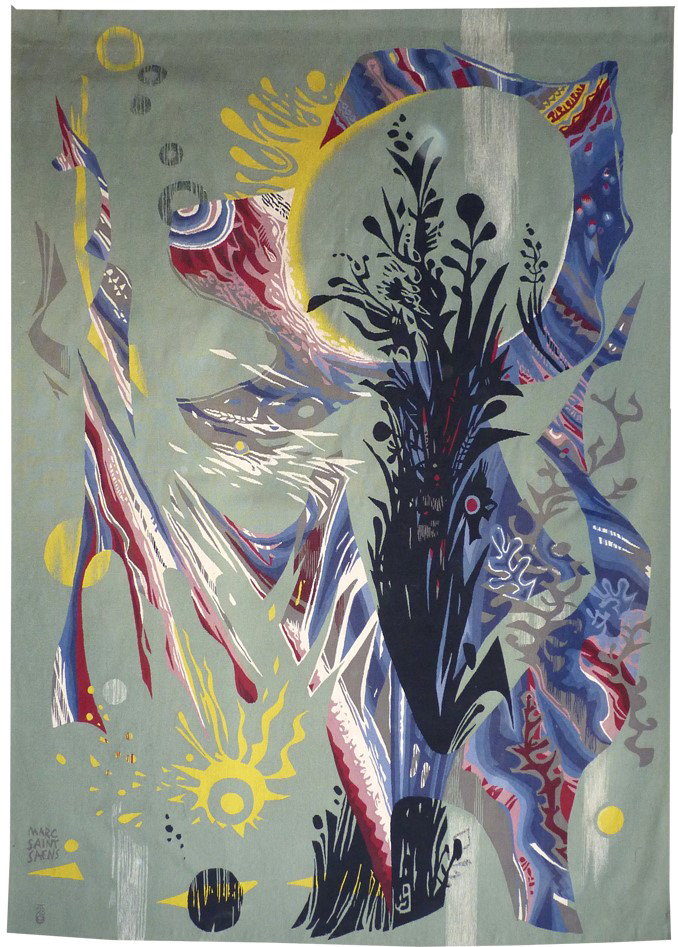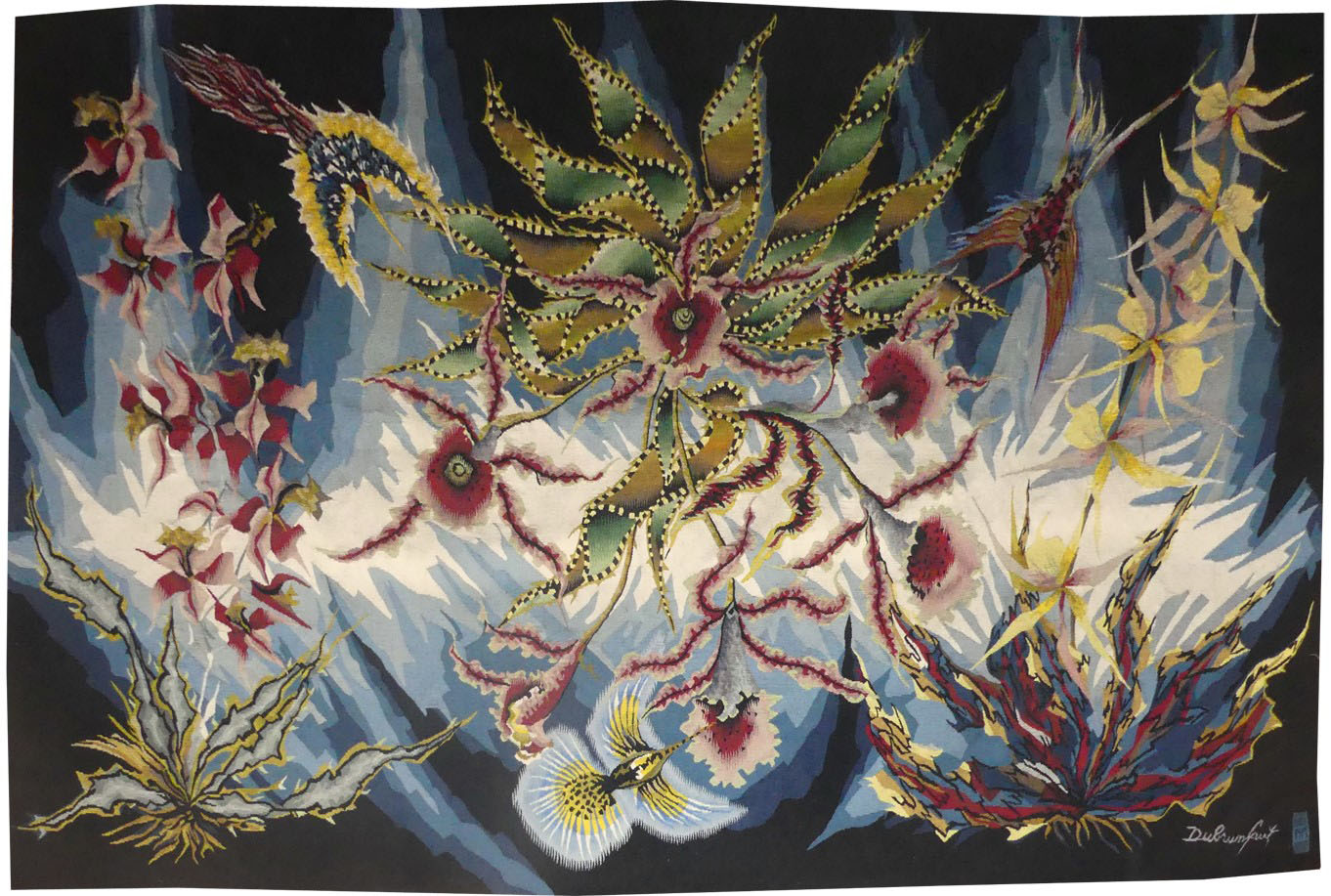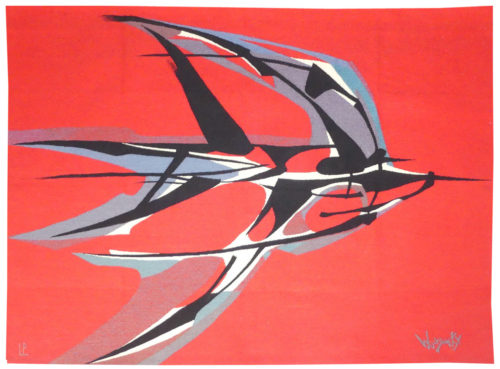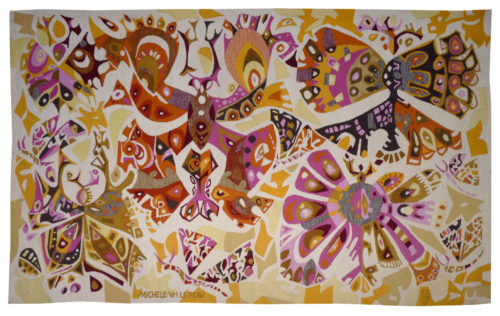-
Aubusson tapestry woven in the Four workshop. With label, n°EA. Circa 1975.Bibliography : Exhibition catalogue Dubrunfaut et la renaissance de la tapisserie, tableaux, dessins, peintures, Musée des Beaux-Arts de Mons, 1982-1983Edmond Dubrunfaut can be considered as the great 20th century renovator of the Belgian tapestry tradition. He founded a weavers’ workshop in Tournai as early as 1942, then, in 1947, created the Centre de Rénovation de la Tapisserie de Tournai. He produced for various Belgian workshops (Chaudoir, de Wit,...) numerous cartoons destined notably to adorn Belgian embassies throughout the world. Moreover, Dubrunfaut was a teacher of monumental art forms at the Academie des Beaux-Arts de Mons from 1947 to 1978 and then, in 1979, contributed to the creation of the Fondation de la tapisserie, des arts du tissu et des arts muraux de Tournai, a veritable heritage centre for the art of the tapestry in Wallonie. His style, characterised by figuration, strong colour contrasts, draws direct inspiration from nature and animal life (as with Perrot, for example, this artist has a net predilection for birdlife). Towards the end of his career, Dubrunfaut tended to a language of fantasy (whose sharpened forms are reminiscent of Marc Petit), and whose use of motif (humming birds and exotic vegetation) looks over its shoulder at Lurçat.
-
Oiseau pilote (Pilot bird)
Aubusson tapestry woven in the Legoueix workshop. With signed label, n°1/6. 1969.A member of the A.P.C.T. (Association des Peintres-Cartonniers de Tapisserie), Wogensky is one of the many artists who would follow in Lurçat’s footsteps immediately after the war. At first influenced by his predecessor, Wogensky’s subsequent work (159 cartoons according to the 1989 exhibition catalogue) would evolve during the 1960’s towards a, not completely self-avowed, lyrical abstraction, from cosmic-astronomical themes expressed in decomposed, moving, birdlike shapes to cartoons both more refined and less dense. Although always claiming to be a painter, the artist’s conception of tapestry is extremely well thought out : “the realisation of a mural cartoon…. requires the consideration of a space which is no longer ours alone, by the nature of its dimensions, its scale, it also imposes a grand gesture which transforms and accentuates our presence.” « Oiseau pilote » in the singular, like its path « time-weaving » its way through a red sky (cf. “Oiseaux de Midi”, or “Envol” from the same year) forming a shape (or even a veritable dynamic!) showing the way and guiding us to follow... Bibliography : Exhibition catalogue Robert Wogensky, Aubusson, Musée départemental de la tapisserie, 1989 Exhibition catalogue Robert Wogensky, Angers, Musée Jean Lurçat et de la Tapisserie Contemporaine, 1989 Exhibition Catalogue Tissages d’ateliers-tissages d’artistes, Angers, Musée Jean Lurçat et de la Tapisserie Contemporaine, 2004 -
Papillons de cocagne (ideal butterflies)
Aubusson tapestry, woven in the Picaud workshop. Complete with certificate of origin signed by the artist. Circa 1970. Michèle Van Hout le Beau designed numerous cartoons in the 1960’s and 70’s, working in collaboration with several workshops in Aubusson and receiving some state commissions (she participated along with Soulages, Lagrange, Alechinsky and others in the decoration of the transatlantic Boeing 707’s for Air France). Her style often involves the use of strident colours (very evocative of the 1970’s) from which emerge foliage, stylised human or animal figures. This cartoon, with its acidic colours is particularly characteristic of the artist’s style ; here we can also observe, on a theme abundantly developed by Lurçat, the different way in which the butterflies are evoked : the subject is here a pretext for highly coloured, geometrical evocations approaching abstraction.





